Multi-function terahertz wave manipulation utilizing Fourier convolution operation metasurface
2022-05-16MinZhong仲敏andJiuShengLi李九生
Min Zhong(仲敏) and Jiu-Sheng Li(李九生)
Center for THz Research,China Jiliang University,Hangzhou 310018,China
Keywords: Fourier convolution operation metasurface,terahertz wave,flexible manipulation
1. Introduction
In recent years, metasurfaces have been gradually developed from passive response to active control of electromagnetic wave. Different manipulation methods have been explored including external applied electronic field, optical pumping, temperature control, and so on. Various controllable devices based metasurface have been developed.[1–5]Although these reported studies have increased the freedom of metasurface regulation, they have many additional requirements on the composition of materials, structural design or working environment, which hinder the metasurface application in active control electromagnetic wave. In order to reduce the demand for external condition of controllable metasurface,Cuiet al.[6]proposed the concept of digital encoded metasurface to realize electromagnetic wave regulation by means of digital coding in microwave region.[7–13]Furthermore, in 2016,Cuiet al.[14]introduced the Fourier convolution theorem in digital signal processing into the coding metasurface. By convolution two different coding sequences, electromagnetic wave regulation with any scattering angle was obtained and further improved the regulation flexibility of the coding metasurface. More recently,the vortex beam carrying orbital angular momentum(OAM)has become a important mean of electromagnetic wave regulation. It can be widely used in modern communication systems.[15–19]At present,most of the orbital angular momentum research is focused on the generation of vortex beams from microwave to optical wave regimes.[20–25]But, there are few literature on terahertz vortex beam generator. Furthermore, metasurface combined with Fourier convolution becomes more meaningful for terahertz vortex beam regulation.
In this paper, we propose a new metasurface based on a combined pattern of outer C-shaped ring and inner rectangular ring. By usign Fourier convolution operation, the proposed metasurface can control vortex terahertz wave splitting,anomalous vortex terahertz wave deflection, and manipulate vortex terahertz wave splitting and deflection simultaneously.The simulation results are consistent with the theoretical predictions. The study shows that the flexible manipulation of terahertz vortex beam has a very high application prospect for improving the capacity of terahertz communication system and the sensitivity of terahertz sensing.
2. Convolution operation metasurface
The matesurface sequence is equivalent to the time signal in digital signal processing, while far-field scattering of the metasurface is similar to the frequency domain in digital signal processing. The product of two signals in the time domain can can be converted to the convolution of two signals in the frequency domain,and the digital convolution theorem can be calculated by
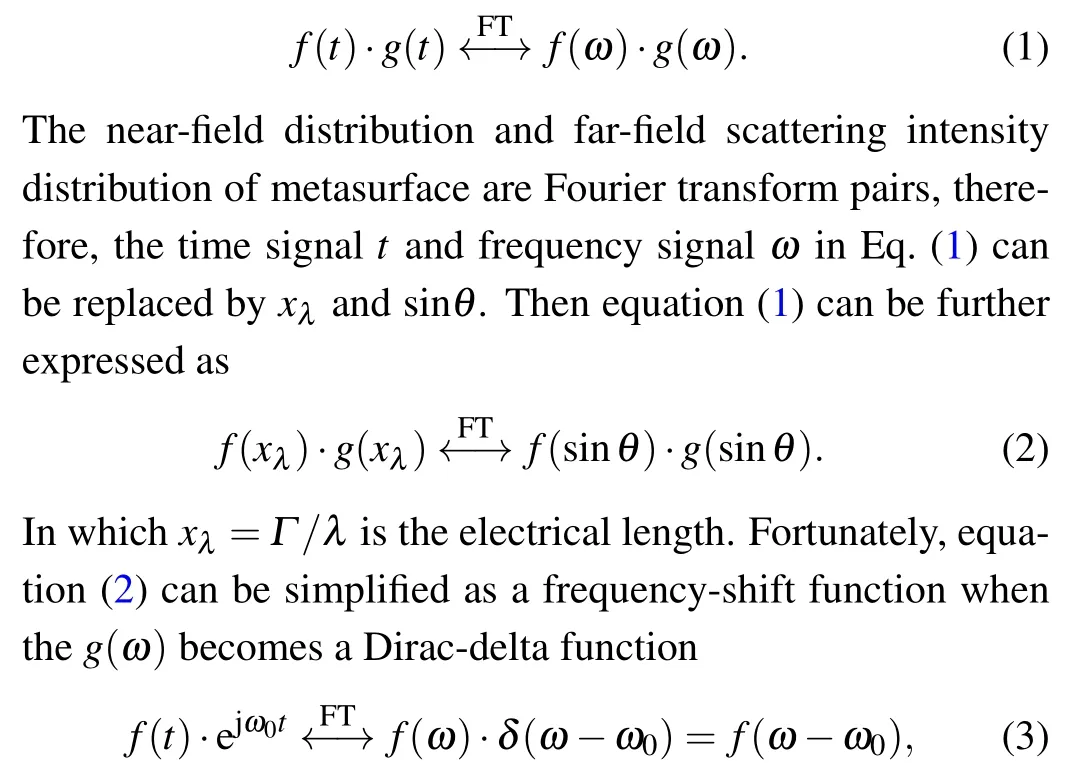
where ejω0tis the time-shift item in time domain, and its frequency spectrum expression isδ(ω). Equation (3) reveals the convolution of a spectrum functionf(ω)with an impulse functionδ(ω-ω), which will cause the spectrum functionf(ω) to shift byωin the frequency domain. Similarly, the far-field scattering pattern of the metasurface can be obtained as

where the item ejsinθ0xλdescribes the metasurface with unity scattering amplitude and gradient phase distribution. Equation (4) demonstrates the product of an initial coded metasurface sequence and an encoded metasurface sequence with gradual phase distribution causes the metasurface far field scattering pattern to deviate from its initial scattering direction.The sum of two encoding metasurface sequences off(xλ)and ejsinθ0xλgenerates a new encoding sequencef(xλ)·ejsinθ0xλ.The scattering angle of this new coded sequence can be given byθ′=sin-1(sinθ1+sinθ2),whereθ1andθ2are the scattering angles of two initial coding sequences. Likely,two coded metasurface sequences off(xλ)and ejsinθ0xλcan also be subtracted. In addition,the new scattering angleθ′andφ′can be obtained for Fourier convolution of two orthogonal gradientencoded sequences as
As mentioned above, the beam scattering can be adjusted in arbitrary direction on Fourier convolution operation metasurfacce. In this article,the coding sequence of generation vortex beam can be added to the gradient coding sequence construct a new coding sequence by Fourier convolution operation,which can flexibly manipulate the vortex terahertz beam in transmission mode.and 2(b) show the reflection amplitude and phase of coding particles of “0”, “1”, “2”, and “3” under circularly polarization incidence. One can clearly see from Fig. 2(a) that the reflection amplitudes of the four coding unit cells labeled with numbers“0”to“3”exceed 0.8 at frequency range of 0.6 THz–0.9 THz. Figure 2(b)illustrates the four coding unit cells fully cover the 180°phase range with a 90°interval by changing rotation angle(α)at 0.5 THz–1.2 THz.

Fig. 1. Coding element structure: (a) 3D plot of coding element; (b) top view of the coding element with rotation angle α; (c)schematic diagram of multi-function terahertz metasurface.
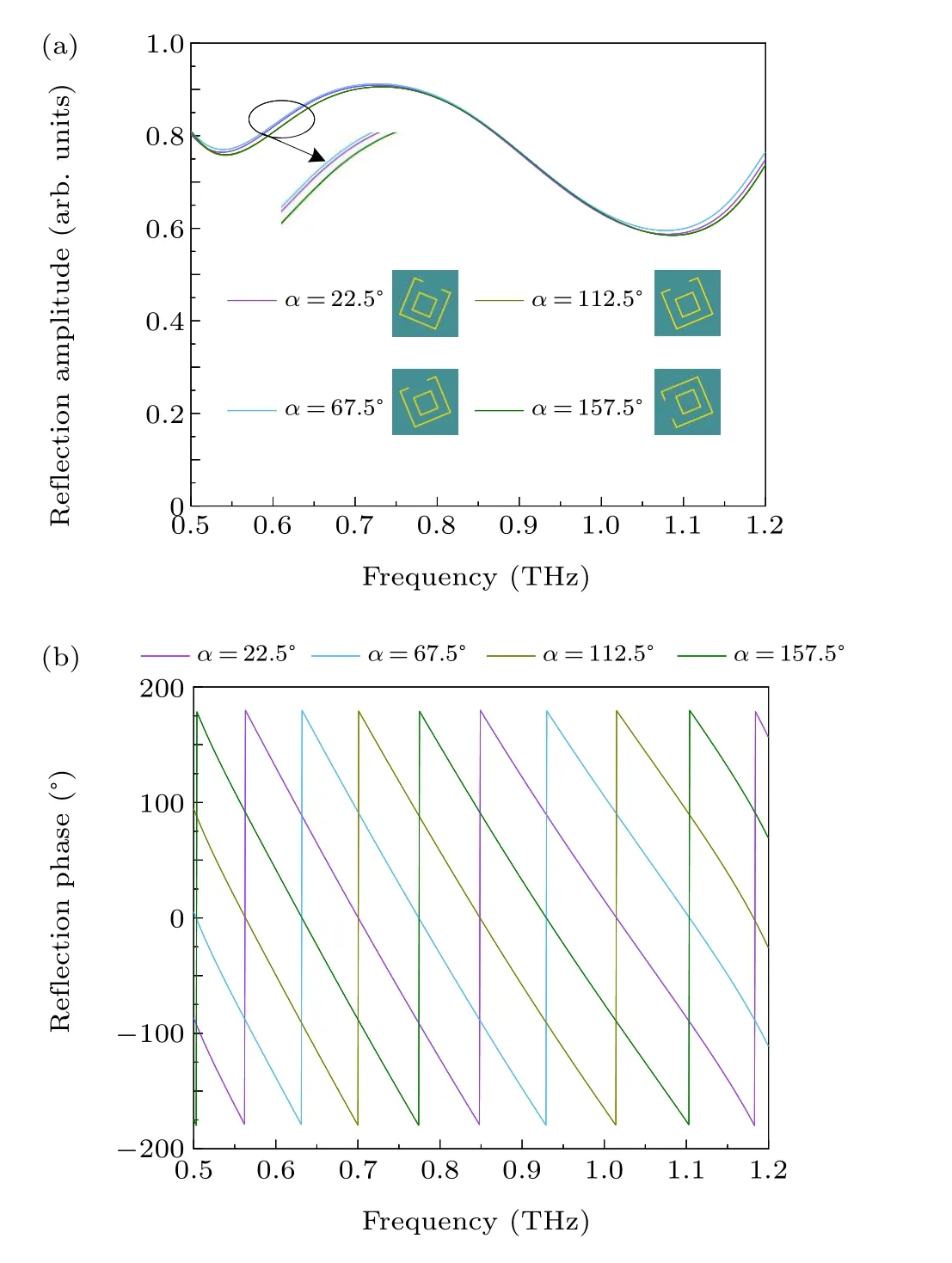
Fig. 2. Reflection amplitude and phase under circularly polarization incidence. (a)reflection amplitude;(b)reflection phase.
3. Fourier convolution operation metasurface
Figure 1(a)shows three-dimensional(3D)schematic diagram of the designed Fourier convolution operation metasurface element, which consists of metallic bottom layer, polyimide dielectric middle layer, and metallic pattern layer, respectively. The optimized dimensions of the coding element are as follows:a=60 μm,b=56 μm,c=30 μm,d=26 μm,p= 100 μm. Here, the polyimide has relative permittivityε=11.9 with thickness ofh=49 μm.Both the top and bottom gold patterns have a thickness of 200 nm. Figure 1(b)displays the top view of coding element by rotating orientation angle(α)of the metallic pattern. For 2-bit coding metasurface, the rotation angle(α)of the coding element varies from 0°to 180°with step width of 22.5°. Figure 1(c)illustrates schematic diagram of multi-function terahertz metasurface. Figures 2(a)
3.1. Terahertz vortex beam splitting manipulation
To generate a vortex beam,the metasurface needs to meet the spiral phase distribution of 2nΔφ=2πl. Where l is the topological charge that can be taken as any integer, and 2nmeans the 2πarea divided into 2π/2n. The phase difference between adjacent areas is fixed at Δφ. According to the generalized Snell’s law and the far-field function of metasurface scattering, the relation among the azimuth angle (φ) of reflected terahertz beam, the length and width (DxandDy) of the unit cell can be calculated byφ=±arctan(Dx/Dy) andφ=π±arctan(Dx/Dy). The pitch angle (θ), which is related to the corresponding terahertz wavelength (λ) in free space and the length of a gradient periodicity, can be given byθ=arcsin(λ/Γ).
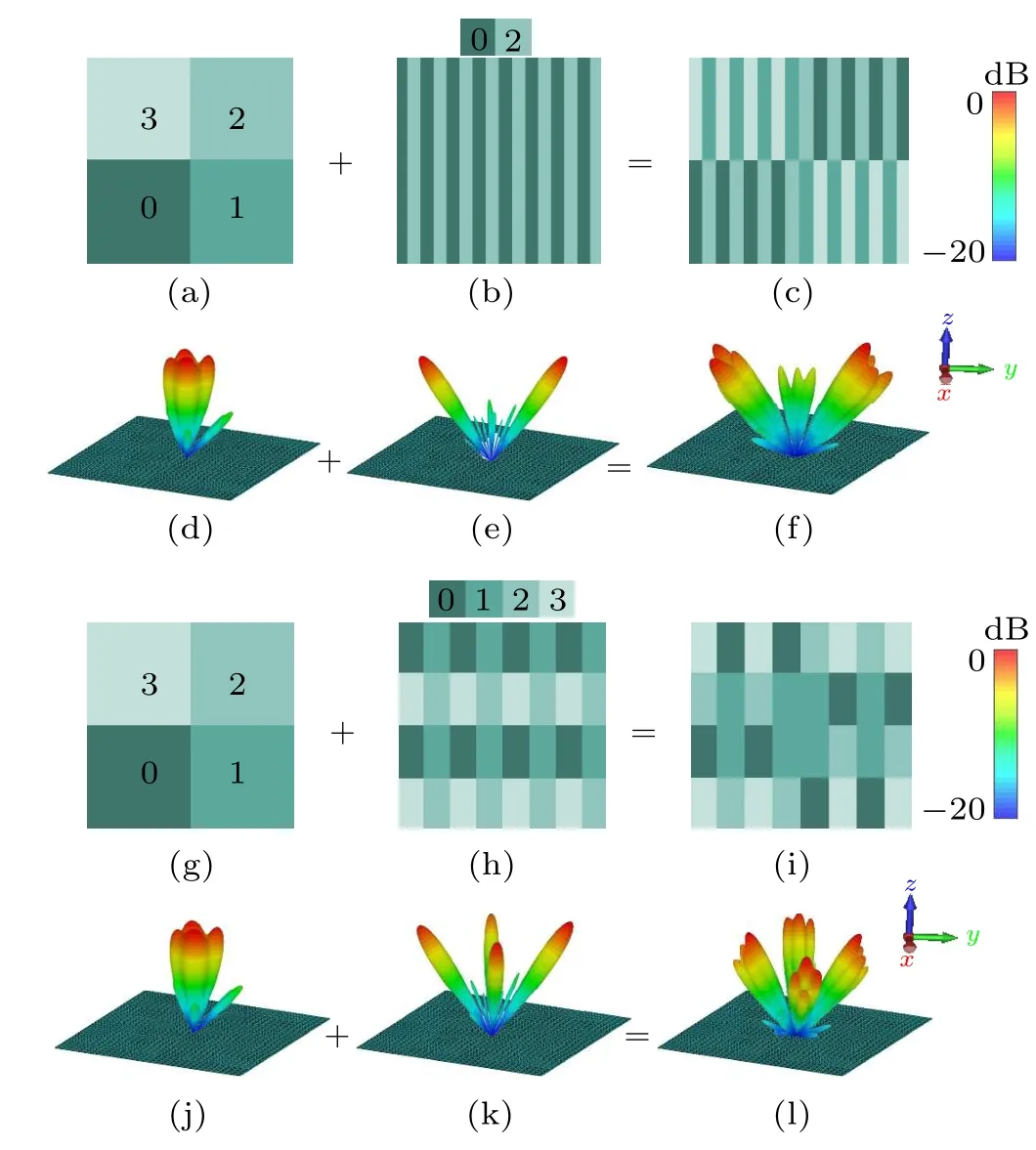
Fig.3. Vortex terahertz beam spitting control. (a)–(c)Coding patterns operation on 2-bit metasurface.(d)–(f)Related 3D scattering fields of two terahertz vortex beams. (g)–(i)Coding patterns operation on 2-bit metasurface. (j)–(l)Corresponding 3D scattering pattern of four terahertz vortex beams.
Figure 3 shows the reflection vortex terahertz beam splitting by Fourier convolution operation on 2-bit metasurface under the normal incidence terahertz wave. As presented in Figs. 3(a)–3(c), one can noted that the Fourier convolution operation between the vortex terahertz beam coding sequence and the“0000222220000222222···”coding sequence arranged along thexaxis obtains two vortex terahertz wave coding sequences. The 3D scattering fields of two terahertz vortex beams under right-handed circularly polarized(RCP) (left-handed circularly polarized (LCP)) at frequency of 0.68 THz are vertically incident on the designed metasurface, as clearly exhibited in Figs. 3(d)–3(f). As displayed in Figs. 3(g)–3(i), it can be observed that the Fourier convolution operation between the generated vortex terahertz beam coding sequence and the coding sequence arranged in“00001111···/22223333···” generates four terahertz vortex wave coding sequences. The corresponding 3D far-field scattering patterns of four terahertz vortex beams at frequency of 0.68 THz are depicted in Figs. 3(j)–3(l). Figures 4(a) and 4(b) describe the two-dimensional (2D) electric field intensity distributions of two and four vortex terahertz beams, respectively. It can be seen from the figure that the incident terahertz wave produces two reflected terahertz vortex beams(θ=33°,φ=0°, 180°) and four reflected terahertz vortex beams (θ=33°,φ=0°, 90°, 180°, 270°). The corresponding 2D scattering patterns of vortex terahertz beams as shown in Fig. 5. Figure 5(a) gives the 2D scattering pattern of two beams at the azimuth angle of 0°. Figure 5(b) shows the 2D scattering pattern of four beams at the azimuth angle of 0°.According to Figs. 3 and 4, one can see that the number and reflection direction of terahertz vortex beams are controlled by the convolution operation coding metasurface.

Fig. 4. Electric field intensity distributions of vortex beams: (a) two vortex beams,(b)four vortex beams.
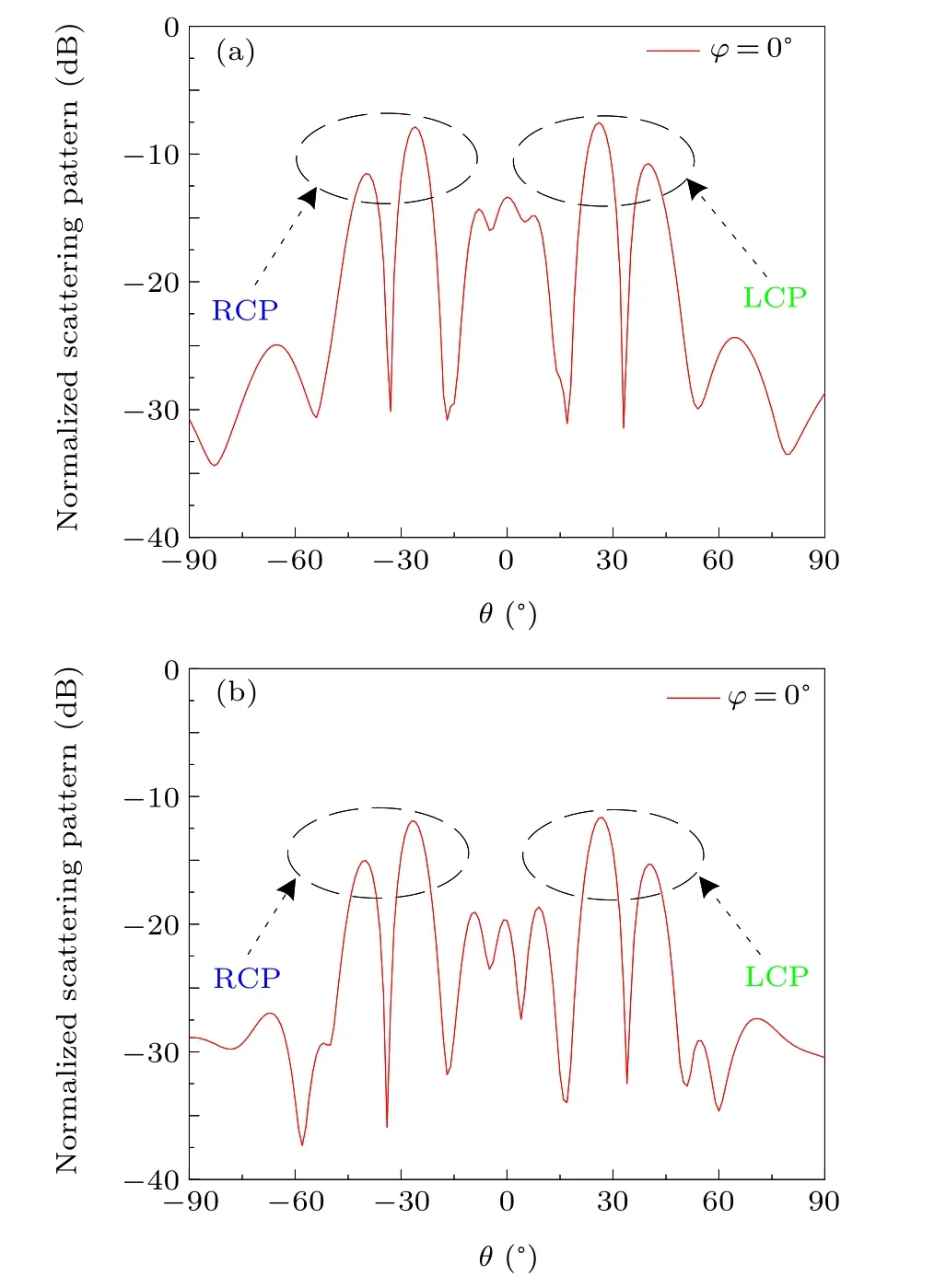
Fig.5.2D scattering patterns of vortex terahertz beams:(a)two vortex beams at the azimuth angle of 0°;(b)four vortex beams at the azimuth angle of 0°.
3.2. Terahertz vortex beam anomalous deflection manipulation
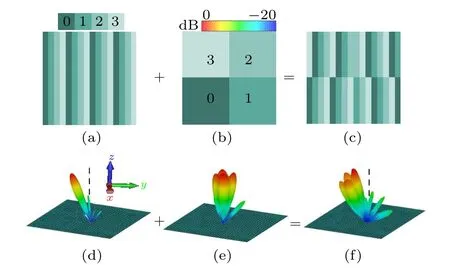
Fig. 6. Vortex terahertz beam anomalous deflection control: (a)–(c) coding patterns operation on a 2-bit metasurface; (d)–(f)3D scattering fields of deflected vortex terahertz beam.

Fig. 7. Near-field and phase distributions of the proposed coding pattern in Fig.6(b),(a)normalized intensity distribution;(b)phase distribution.
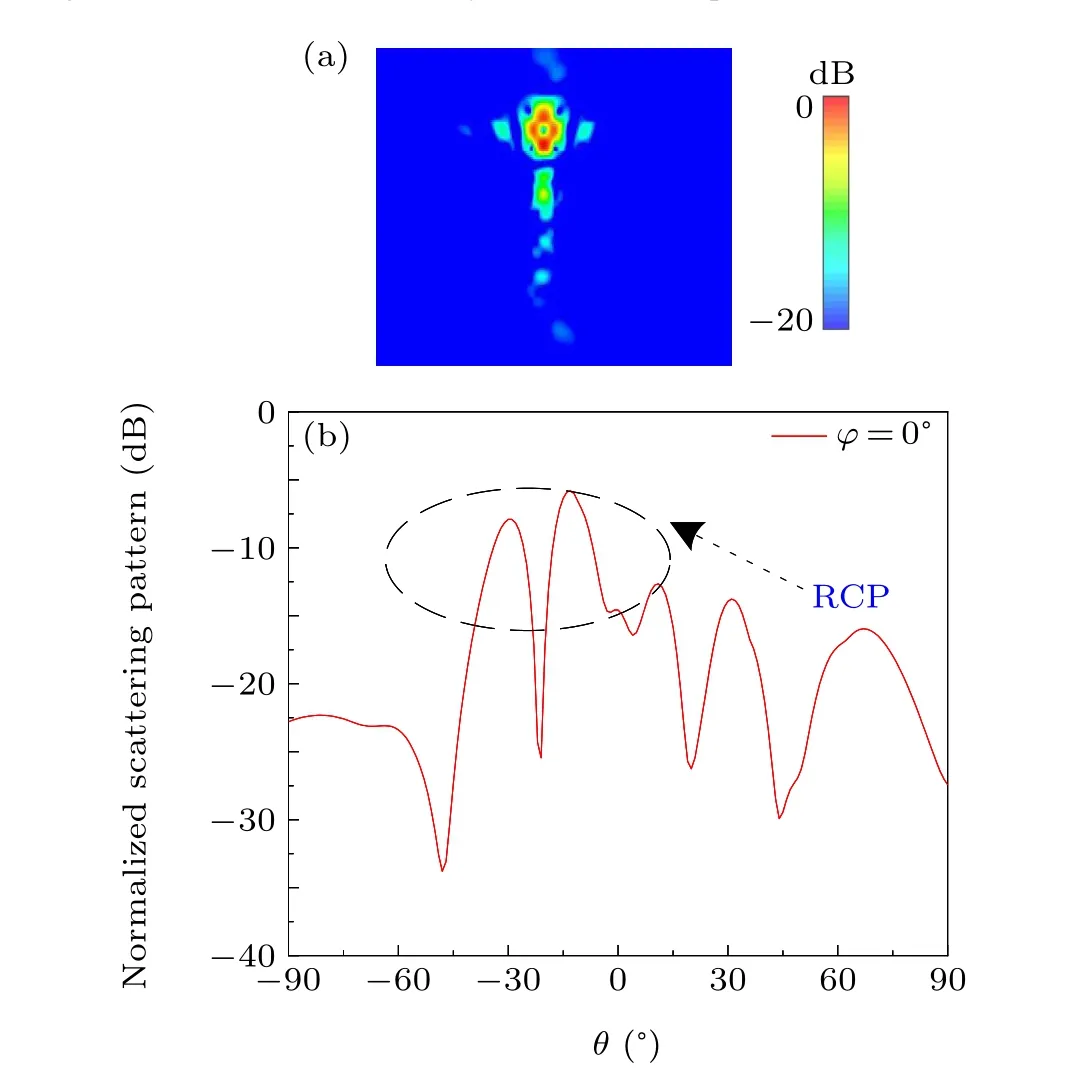
Fig.8. Electric field intensity distributions and 2D scattering pattern of terahertz vortex beams. (a)Electric field intensity distributions,(b)2D scattering pattern of the deflected vortex beam at the azimuth angle of 0°.
Figure 6 shows the deflection control of reflected terahertz wave vortex beam on a Fourier convolution operation 2-bit metasurface. As depicted in Figs. 6(a)–6(c), one can find that the coding patterns of generating deflected terahertz vortex beam is obtained by Fourier convolution of“000111222333···” coding sequence arranged along theyaxis and the generation of terahertz vortex beam coding sequence. Figures 6(d)–6(f) illustrates the 3D far-field scattering pattern of deflected terahertz vortex beam at frequency of 0.68 THz under the incident RCP (LCP) terahertz wave on the proposed metasurface. Figures 7(a) and 7(b) display the normalized intensity distribution and the phase distribution of coding pattern in Fig. 6(b) respectively. Electric field intensity distributions and 2D scattering pattern of vortex terahertz beams are shown in Fig.8. Figure 8(a)illustrates the electric field intensity distributions of deflected terahertz vortex beam and figure 8(b)describes the 2D scattering pattern of deflected terahertz vortex beam at the azimuth angle of 0°. From Figs.7 and 8,one can noted that the terahertz vortex beam deflection can be controlled by the convolution operation of the vortex terahertz beam coding sequence and the gradient coding sequence.
3.3. Terahertz vortexbeam splitting and deflection manipulation simultaneously
In addition, we can observe clearly from Fig. 9 that the incident terahertz wave generates the reflected terahertz vortex beam splitting and deflection control simultaneously.As shown in Figs. 9(a)–9(d), it can be noted that the coding patterns of generating two deflected vortex beams is obtained by Fourier convolution operation of the coding sequence “00112233···” arranged along thexdirection, the coding sequence “000022222000022222···” arranged along theydirection and the coding sequence generated terahertz vortex beam. Under the RCP (LCP) terahertz wave normal incidence, the related 3D far-field scattering patterns of two deflected terahertz vortex beams at frequency of 0.68 THz are exhibited in Figs. 9(i)–9(l). As presented in Figs. 9(e)–9(h), we observe that the coding patterns of generating four deflected vortex beams is obtained by performing Fourier convolution operation of the coding sequence“000011122223333···” along thexdirection, the coding sequence“000000222222···/222222000000···”and the coding sequence generated terahertz vortex beam. The corresponding 3D scattering far-fields of four deflected terahertz vortex beams at frequency of 0.8 THz, as displayed in Figs. 9(m)–9(p). When the terahertz wave is perpendicularly incident on the metasurface composed of the coding sequence in Fig.9(d),the incident terahertz wave generates two reflected terahertz vortex beams with a deflection angle of 33°(see Fig. 9(l)).At this time, the deflection angle of 33°is controlled by the“0000222220000222222···”coding sequence arranged along theyaxis. Similarly, when the terahertz wave is perpendicularly incident on the metasurface composed of the coding sequence in Fig. 9(h), four reflected terahertz vortex beams are generated with a deflection angle of 18°(see Fig. 9(p)),which is controlled by the“000011122223333···”coding sequence arranged along theyaxis. Figures 10(a) and 10(b)show the two-dimensional electric field distribution of two and four vortex terahertz wave deflections, respectively. It can be seen clearly from the figure that both two and four terahertz vortex beams deviate from the center point. It can be found from Figs.9 and 10 that the convolution operation between the vortex terahertz beam coding sequence and different coding sequences can generate multiple terahertz wave vortex beams with different deflective scattering angles.

Fig. 9. Vortex terahertz beam splitting and deflection control. (a)–(h) Coding patterns operation on a 2-bit metasurface. (i)–(l) Related 3D scattering fields of two deflected vortex terahertz beams. (m)–(p) Corresponding 3D scattering fields of four deflected vortex terahertz beams.

Fig.10. Electric field intensity distributions of vortex terahertz beams. Two beams(a),four beams(b)deflected vortex terahertz wave beams.
4. Conclusion
In summary,we proposed a novel Fourier convolution operation metasurface,which is made of bottom metal layer,intermediate dielectric layer,and top metal pattern with a combined pattern of outer C-shaped ring and inner rectangular ring. A coding sequence generated by Fourier convolution,the presented metasurface can realize multi-function manipulation for the incident terahertz wave, such as multi terahertz beams, terahertz vortex beam with arbitrary scattering angle,and multi terahertz vortex beam with a certain deflection angle.The study provides a new idea for flexible control of terahertz vortex beam,and also offers an effective method for terahertz wave manipulation.
Acknowledgments
Project supported by the National Natural Science Foundation of China (Grant Nos. 61871355 and 61831012), the Talent Project of Zhejiang Provincial Department of Science and Technology (Grant No. 2018R52043), and the Research Funds for Universities of Zhejiang Province, China (Grant Nos.2020YW20 and 2021YW86).
杂志排行
Chinese Physics B的其它文章
- Erratum to“Boundary layer flow and heat transfer of a Casson fluid past a symmetric porous wedge with surface heat flux”
- Erratum to“Accurate GW0 band gaps and their phonon-induced renormalization in solids”
- A novel method for identifying influential nodes in complex networks based on gravity model
- Voter model on adaptive networks
- A novel car-following model by sharing cooperative information transmission delayed effect under V2X environment and its additional energy consumption
- GeSn(0.524 eV)single-junction thermophotovoltaic cells based on the device transport model
